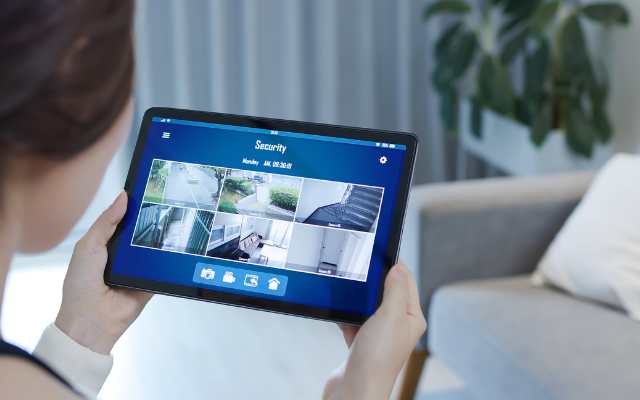How to Choose and Set Up the Best Home Security Camera System

Home security cameras are a great way to keep your home and family safe. With so many different options available, choosing and setting up the right system can seem overwhelming. In this article, we’ll provide some tips to help you choose the best home security camera system and set it up for optimal performance.
How to Choose and Set Up the Best Home Security Camera System
- Determine Your Needs Before you start shopping for a home security camera system, it’s important to determine what your specific needs are. Do you want indoor or outdoor cameras? Do you need a camera that can pan, tilt, and zoom? Do you want cameras that can be accessed remotely via a smartphone app? Once you have a clear understanding of your needs, you can begin to narrow down your options.
- Consider the Resolution The resolution of a camera determines the clarity of the image it captures. When choosing a home security camera system, it’s important to consider the resolution of the cameras. Generally, higher resolution cameras will provide clearer images, but they may also be more expensive.
- Choose the Right Type of Camera There are several types of home security cameras available, including wired, wireless, and battery-powered cameras. Wired cameras require a physical connection to a power source and are typically more reliable, while wireless and battery-powered cameras are easier to install and can be moved around more easily. Choose the type of camera that best fits your needs and budget.
- Decide on a Storage Option Home security cameras typically record footage that can be viewed later. The footage can be stored locally on a hard drive or in the cloud. Local storage can be more secure, but it may be more difficult to access the footage remotely. Cloud storage is typically easier to access remotely, but it may be less secure.
- Set Up the Cameras Once you’ve chosen a home security camera system, it’s time to set up the cameras. Follow the manufacturer’s instructions carefully to ensure that the cameras are installed correctly. Make sure the cameras are positioned in areas where they can capture the best footage. If you’re not sure where to position the cameras, consider consulting with a professional installer.
- Test the System After the cameras are installed, test the system to make sure everything is working properly. Check the camera angles and make sure the footage is clear. Test the remote access features to make sure you can access the footage from your smartphone or computer.
Your Security Camera Options
There are several security camera options available on the market today, each with its own features and benefits. Here are some of the most common types of security cameras:
- Indoor Cameras: These cameras are designed to be used inside your home and are typically smaller and more discreet than outdoor cameras. They can be used to monitor the activity in a specific room or area of your home.
- Outdoor Cameras: These cameras are designed to be used outside your home and are built to withstand the elements. They are typically larger and more visible than indoor cameras and can be used to monitor the exterior of your home, including your driveway, front door, and backyard.
- Wired Cameras: These cameras are connected to your home’s electrical system and require a physical connection to a power source. They are typically more reliable than wireless cameras and are a good choice if you want a camera that is always on.
- Wireless Cameras: These cameras are connected to your home’s Wi-Fi network and can be accessed remotely using a smartphone app. They are typically easier to install than wired cameras and can be moved around more easily.
- Battery-Powered Cameras: These cameras are similar to wireless cameras, but they are powered by batteries instead of being connected to a power source. They are a good choice if you want a camera that can be easily moved around.
- Pan-Tilt-Zoom Cameras: These cameras can be controlled remotely and allow you to pan, tilt, and zoom the camera lens to get a better view of your home. They are typically more expensive than other types of cameras, but they offer more flexibility in terms of the areas you can monitor.
- Doorbell Cameras: These cameras are built into your doorbell and allow you to see who is at your front door without opening it. They are a good choice if you want to monitor who is coming and going from your home.
- 360-Degree Cameras: 360-degree cameras can capture a full view of a room or area, eliminating blind spots. They are ideal for monitoring large areas such as living rooms or conference rooms.
When choosing a security camera, it’s important to consider your specific needs and budget. Think about the areas of your home you want to monitor and whether you need a camera that is always on or one that can be accessed remotely. With so many options available, you’re sure to find a security camera that meets your needs and helps keep your home and family safe.
Latest Trend In Security Cameras
One of the latest trends in security cameras is the use of artificial intelligence (AI) and machine learning (ML) to enhance their capabilities. With the help of AI and ML algorithms, security cameras can now detect and analyze data in real time, making them more effective at identifying and responding to potential security threats.
One application of AI and ML in security cameras is facial recognition technology. With this technology, cameras can identify individuals and match them against a database of known criminals or persons of interest. This can help law enforcement agencies to identify and apprehend suspects more quickly.
Another application of AI and ML in security cameras is object recognition. Cameras can now detect specific objects, such as weapons or suspicious packages, and alert security personnel when these objects are detected. This can help prevent potential security threats before they escalate.
In addition to AI and ML, another trend in security cameras is the use of edge computing. With edge computing, cameras can process data locally on the device, rather than sending it to a centralized server for processing. This can reduce the latency associated with processing large amounts of data and allow cameras to respond to potential security threats more quickly.
Finally, there is a growing trend toward integrating security cameras with other smart home devices, such as smart locks and smart lights. This allows homeowners to create a fully integrated security system that can be controlled by a single app.
Overall, the latest trends in security cameras are focused on improving their capabilities and making them more effective at identifying and responding to potential security threats. As technology continues to evolve, we can expect to see even more advanced features and capabilities in the years to come.
- Hidden security camera: regulations, tips and more
- What is software security and why is it so important now?
- How to Enable WhatsApp Security Code Alerts
Conclusion
Choosing and setting up a home security camera system requires some planning and consideration. By determining your needs, considering the resolution, choosing the right type of camera, deciding on a storage option, and setting up the cameras correctly, you can ensure that your home and family are well protected.







